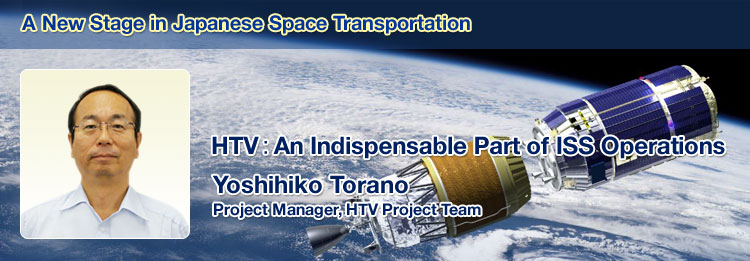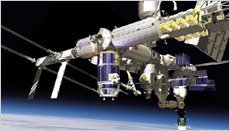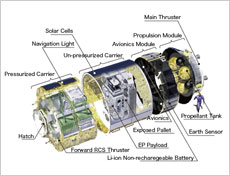
The H-II Transfer Vehicle (HTV) is an unmanned spacecraft built to deliver supplies to the International Space Station (ISS). It has a cylinder-like shape about 10 meters long, with a diameter of 4.4 meters at its widest point, and has a mass of approximately 10.5 tons. The HTV consists of a main body and two cargo modules - the Pressurized Logistic Carrier (PLC), and the Unpressurized Logistic Carrier (ULC) - which can carry a total of 6 tons of supplies. The PLC will be kept at one atmospheric pressure, i.e. the same pressure as on the ground, and will transport supplies for the astronauts along with equipment for experiments. The ULC will carry supplies exposed to the vacuum conditions in space, such as batteries, replacement units for the attitude control devices that stabilize the ISS attitude, and equipment for extravehicular experiments. The main body, in turn, consists of an Avionics Module and a Propulsion Module. The Avionics Module is equipped with computers, power sources and communication devices, and will act as HTV's "brain." The Propulsion Module is equipped with the engines and propellant tanks, and will provide the propulsion force to change the orbit or control the position of the HTV.

The HTV right before it is captured by the robotic arm of the ISS (Artist's Concept)
Once it is in position, the HTV will dock with the ISS. Rather than docking in the traditional way, the HTV will come to a relative stop at a designated point, such described as "capture box" and the space station's robotic arm (SSRMS for Space Station Remote Manipulator System) will grab HTV's Grapple Fixture. This will be the first such spacecraft docking ever carried out. It will require the HTV to hold its Grapple Fixture in the space of about one cubic meter for more than five minutes, so that the robotic arm can safely grab it.
This docking method was chosen for several reasons: to allow for a wider opening of the cargo module, so it could transport larger cargos; because some equipments required were readily available; and because it is more cost effective than other methods, such as those used by the Space Shuttle or the Russian Progress spacecraft, all of which were originally developed during the Soviet era.
When the HTV is docked with the ISS, astronauts working in the ISS will open the hatch of the PLC and transfer its supplies. As the air and the atmospheric pressure inside this module is the same as on the ground, astronauts can work under the same conditions as inside the ISS. In the ULC, supplies are transported on the exposed pallets, which are like drawers in a desk, and these will be pulled out using the SSRMS. After all the supplies are loaded on the ISS, any unnecessary equipment to be discarded or returned to Earth will be loaded on the HTV. The HTV will separate from the ISS after about one month, and re-enter Earth's atmosphere. Most of the HTV will burn up due to the high temperatures during re-entry, and only some highly heat-resistant components will splash in a pre-determined area in the ocean.
The launch of the first HTV - the Proto-Flight Model - is scheduled for 2009. After that, one or two HTVs are scheduled for launch every year. Seven HTVs in total will deliver supplies to the ISS.

The HTV docked with the ISS (Artist's Concept)
The ISS, which flies at a maximum speed of 7.7 kilometers per second at an altitude of around 400 kilometers, has a complicated shape, so it tends to sway and roll during flight. In order to approach the ISS under such perturbed conditions, the HTV, which weighs approximately 16.5 tons, will have to delicately control its position, using four main engines (two of which are backup systems) and 28 thrusters for attitude/translational control (14 of them backup systems). Using its world-leading technology, the HTV will come to a relative stop at approximately 10 meters away from the ISS.
As there are astronauts inside the ISS, any collision would be catastrophic. Thus, various safety steps have to be taken. For example, the HTV has the ability to approach the ISS automatically, but it will stop first at 300 meters and then again 30 meters below the ISS, and will not proceed further until given the command from the ground. In addition, one or sometimes two redundancy is required for each component, so that even if a part malfunctions, the HTV can still fly safely. For instance, electric power is supplied by two systems, each of which controls half of the total power, but if one system malfunctions, the other system will instantly supply power to the entire vehicle. There are also three levels of decision-making computers on board: three first-level computers, two more backing them up, and an emergency third-level computer that can function in case all the others fail. In case of trouble, control of the HTV will be switched to the redundant string by a majority decision among the first-level or higher-level computers.
